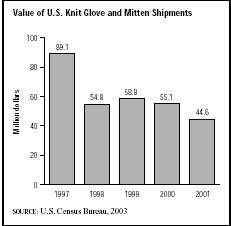SIC 2259
KNITTING MILLS, NOT ELSEWHERE CLASSIFIED
Companies in this classification are primarily engaged in knitting gloves and other articles not elsewhere classified. Establishments primarily making woven or knit fabric gloves and mittens from purchased fabrics are classified in SIC 2381: Yarn Spinning Mills.
NAICS Code(s)
315191 (Outerwear Knitting Mills)
315192 (Underwear and Nightwear Knitting Mills)
313241 (Weft Knit Fabric Mills)
313249 (Other Knit Fabric and Lace Mills)
Products manufactured by companies in this category include bags and bagging, bedspreads, curtains, dishcloths, elastic girdle blanks, girdles and other foundation garments, gloves, shoe linings, mittens, stockinettes, towels, and washcloths.
Like many companies in the knitting business, firms in this category tend to buy yarn that is customized to suit their requirements instead of running their own dyeing and finishing operations. When dyeing and finishing is required, the companies either have the work done on a commission basis or, in some cases, sell goods to dyers and finishers who in turn deliver the finished fabric. For some types of knit work gloves, dyeing and finishing is not necessary; the gloves are made from greige fabric and left the natural color.
Many companies in this category are small, family-owned businesses serving niche markets. According to the U.S. Census Bureau, firms in the other apparel knitting mills classification shipped $3.5 billion worth of goods in 2000, compared to $5.03 billion in 1997. One of the largest segments of this industry—knit gloves and mittens—saw the value of product shipments decline from $89.1 million in 1997 to $44.6 million in 2001. This downward trend reflects a general decline in the textiles industry due to increased foreign competition.
Employees of this industry work as sewing machine operators, textile draw-out and winding machine workers, hand packers and packagers, inspectors, industrial machinery mechanics, textile bleaching and dyeing machine workers, testers, hand workers, textile machine setters and set-up operators, blue collar worker supervisors, general managers, and material movers and handlers.
Between 1997 and 2000 the number of people employed in this category decreased from 47,095 to 32,232. Total payroll in the segment was $736 million. The industry's 543,000 production workers were paid an average hourly wage of $9.56 in the early 2000s.

In the early 2000s, more than 60 percent of the firms involved in this industry had at least 20 employees. These larger firms accounted for the majority of the merchandise shipped in the category, and they paid the lion's share of the total wages. North Carolina had the largest number of companies in this segment, followed by New York and New Jersey.
Various diversified textile companies produced goods in this category, but among those who made it their primary business, Beacon Looms Inc. (New York) was the largest. Other industry leaders included Dorothy's Ruffled Originals Inc. (Wilmington, North Carolina); Scott Mills Inc. (Plymouth Meeting, Pennsylvania); and Arlington Hat Company Inc. (Long Island City, New York).
Technological advances during the 1990s occurred in three areas throughout the entire textile industry: computeraided design (CAD), production, and communications; new modular manufacturing systems; and ergonomics (work place instruments designed to improve the safety, health, and efficiency of workers). Smaller firms were often the least efficient. Miscellaneous knitting mills usually had only a few knitting machines, which were either circular or flat machines depending on the product made.
Many of the newer machines were quieter, easier to operate, and designed to reduce workers' stress and injury. Particular emphasis was placed on reducing the repetitive-motion injuries typical of apparel workers that had led to more government regulations, higher workers' compensation costs, and rising health care costs.
Further Reading
U.S. Census Bureau. "Current Industrial Reports: Apparel 2002." August 2003. Available from http://www.census.gov/industry/1/mq315a025.pdf .
——. "Statistics for Industry Groups and Industries: 2000." February 2002. Available from http://www.census.gov/prod/2002pubs/m00as-1.pdf .
U.S. Census Bureau. "Value of Shipment for Product Classes: 2001 and Earlier Years." December 2002. Available from http://www.census.gov/prod/2003pubs/m01as-2.pdf .
Comment about this article, ask questions, or add new information about this topic: